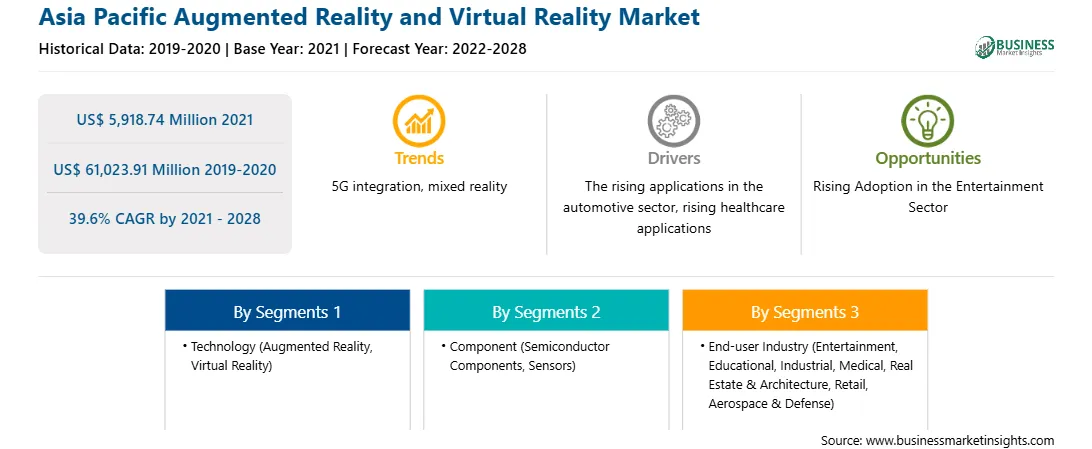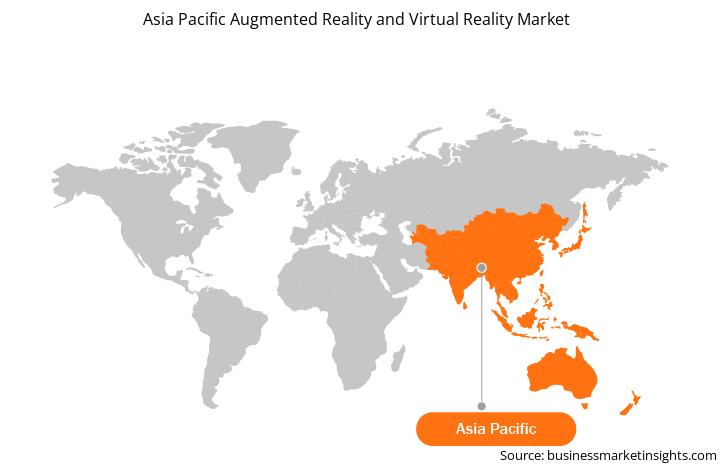Asia Pacific Augmented Reality and Virtual Reality Market
No. of Pages: 125 | Report Code: BMIRE00025060 | Category: Electronics and Semiconductor
No. of Pages: 125 | Report Code: BMIRE00025060 | Category: Electronics and Semiconductor
Customer support departments have improved significantly due to advancements in AI-powered chatbots and virtual assistants. However, chatbots experience difficulties with remote troubleshooting, which is a major challenge the customer care team faces. The integration of virtual reality in customer service has been critical for retailers in consumer engagement and consumer satisfaction. Moreover, fundamental and challenging issues can be resolved in less time using this technology after ending the communication between customers and customer care departments. Implementing excellent customer service initiatives for profitable businesses shows customers respect and loyalty. The retail sector is incorporating virtual reality, the most advanced technology that creates an immersive experience with a powerful sensory effect and a strong emotional connection. Companies use this connection to engage with customers in new and relevant ways. When emotionally connected with a brand, customers are likely to repeat purchases and become brand loyalists. Furthermore, virtual reality provides a highly realistic level of customer experience. Marketers can create different VR ads to display products in new ways. Thus, the rising use of virtual reality solutions across retail stores is driving the augmented reality and virtual reality market growth.
Strategic insights for the Asia Pacific Augmented Reality and Virtual Reality provides data-driven analysis of the industry landscape, including current trends, key players, and regional nuances. These insights offer actionable recommendations, enabling readers to differentiate themselves from competitors by identifying untapped segments or developing unique value propositions. Leveraging data analytics, these insights help industry players anticipate the market shifts, whether investors, manufacturers, or other stakeholders. A future-oriented perspective is essential, helping stakeholders anticipate market shifts and position themselves for long-term success in this dynamic region. Ultimately, effective strategic insights empower readers to make informed decisions that drive profitability and achieve their business objectives within the market.

| Report Attribute | Details |
|---|---|
| Market size in 2021 | US$ 5,918.74 Million |
| Market Size by 2028 | US$ 61,023.91 Million |
| Global CAGR (2021 - 2028) | 39.6% |
| Historical Data | 2019-2020 |
| Forecast period | 2022-2028 |
| Segments Covered |
By Technology
|
| Regions and Countries Covered | Asia-Pacific
|
| Market leaders and key company profiles |
The geographic scope of the Asia Pacific Augmented Reality and Virtual Reality refers to the specific areas in which a business operates and competes. Understanding local distinctions, such as diverse consumer preferences (e.g., demand for specific plug types or battery backup durations), varying economic conditions, and regulatory environments, is crucial for tailoring strategies to specific markets. Businesses can expand their reach by identifying underserved areas or adapting their offerings to meet local demands. A clear market focus allows for more effective resource allocation, targeted marketing campaigns, and better positioning against local competitors, ultimately driving growth in those targeted areas.

The Asia-Pacific augmented reality and virtual reality market is segmented into technology, component, end-user industry, and country. Based on technology, the market is bifurcated into augmented reality and virtual reality. In 2020, the augmented reality segment held the largest share of the Asia-Pacific augmented reality and virtual reality market. Based on components, the market is segmented into sensors, semiconductor components, and others. In 2020, the semiconductor components segment held the largest share of the Asia-Pacific augmented reality and virtual reality market. Based on end-user industry, the market is segmented into entertainment, educational, industrial, medical, real estate & architecture, retail, aerospace & defense, and others. In 2020, the entertainment segment held the largest share of the Asia-Pacific augmented reality and virtual reality market. Similarly, based on country, the Asia-Pacific augmented reality and virtual reality market is segmented into China, Japan, India, Australia, South Korea, and the Rest of Asia-Pacific. China held a substantial share of the market in 2020. EON Reality, Google LLC, Immersive Gaze, Simulanis Solutions Private Limited, Vuzix Corporation, and YeppAR are among the leading companies in the Asia-Pacific augmented reality and virtual reality market.
The Asia Pacific Augmented Reality and Virtual Reality Market is valued at US$ 5,918.74 Million in 2021, it is projected to reach US$ 61,023.91 Million by 2028.
As per our report Asia Pacific Augmented Reality and Virtual Reality Market, the market size is valued at US$ 5,918.74 Million in 2021, projecting it to reach US$ 61,023.91 Million by 2028. This translates to a CAGR of approximately 39.6% during the forecast period.
The Asia Pacific Augmented Reality and Virtual Reality Market report typically cover these key segments-
The historic period, base year, and forecast period can vary slightly depending on the specific market research report. However, for the Asia Pacific Augmented Reality and Virtual Reality Market report:
The Asia Pacific Augmented Reality and Virtual Reality Market is populated by several key players, each contributing to its growth and innovation. Some of the major players include:
The Asia Pacific Augmented Reality and Virtual Reality Market report is valuable for diverse stakeholders, including:
Essentially, anyone involved in or considering involvement in the Asia Pacific Augmented Reality and Virtual Reality Market value chain can benefit from the information contained in a comprehensive market report.